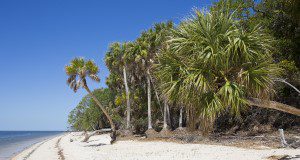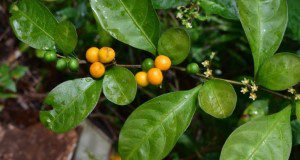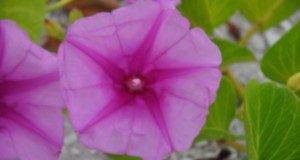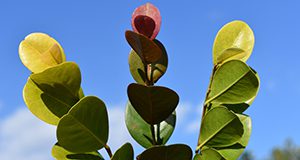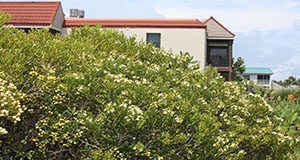Florida is considered by some to be the lightning capital of the world. Florida has on average 3,500 cloud-to-ground lightning strikes per day and 1.2 million strikes per year. Given so many strikes, the probability of damage to certain palms is significant. Coconut palms, royal palms, and Washington palms are particularly vulnerable due to their great heights, but other tall palms may be equally susceptible. This new 6-page publication of the UF/IFAS Environmental Horticulture Department describes and includes many helpful photos of symptoms of lightning damage as well as lightning protection systems. Written by Stephen H. Brown, Douglas Caldwell, and Ralph Mitchell.
https://edis.ifas.ufl.edu/ep598
Tag: Stephen H. Brown
Distribution, Identification and Management of Two-Leaf Nightshade (Solanum diphyllum), an Invasive Plant in Florida
Two-leaf nightshade, Solanum diphyllum, is a member of the Solanaceae or potato family. It is native to Mexico southwards to Costa Rica. It has escaped cultivation in Florida and grows as far north as Duval County and from Volusia County south to Miami-Dade County. A “bird-dispersed” volunteer, it occurs in urban and conservation areas and on disturbed land. The plants produce abundant berries with many many small seeds. This new 5-page publication of the UF/IFAS Environmental Horticulture Department is primarily intended for Florida gardeners, landscapers, and land managers, and it contains information on identification, flowering, fruiting, and management recommendations for this widely occurring plant. Written by Stephen H. Brown, Chris Marble, and Stephen F. Enloe.
https://edis.ifas.ufl.edu/ep588
Railroad Vine (Ipomoea pes-caprae): Identification and Uses
Railroad vine is one of the most widely distributed beach plants in the world. The moving sand and salt spray make the beach environment a harsh one, and the plants that live there are specialized to colonize this environment. This new 7-page document, published by the UF/IFAS Environmental Horticulture Department, describes railroad vine’s leaves, flowers, fruit, planting and maintenance, and insect and disease problems. Written by Stephen H. Brown and Marc S. Frank.
https://edis.ifas.ufl.edu/ep587
Sea Lavender (Heliotropium gnaphalodes L.): Identification and Uses
Sea lavender is a native plant found naturally along the Atlantic coast of central and south Florida. This 7-page document discusses this species’ identification and uses. Written by Stephen H. Brown, Marc S. Frank, and Andrew K. Koeser and published by the UF/IFAS Environmental Horticulture Department, August 2018.
http://edis.ifas.ufl.edu/ep563
Caterpillar Pests of Tiki Huts and Other Thatched Structures
Two species of caterpillars that eat dried sabal palm leaves have been causing problems with thatched structures. If you’ve got a chickee or are planning to get one, you can take steps to protect the thatch. Learn how to identify and manage the two caterpillar pests in this 4-page fact sheet written by Stephen H. Brown and Lyle J. Buss and published by the UF/IFAS Entomology and Nematology Department.
http://edis.ifas.ufl.edu/in1213
Cocoplum (Chrysobalanus icaco L.) Identification and Uses
Cocoplum is one of two native Florida plants in the Chrysobalanaceae family, and is found in a variety of habitats. This 9-page document discusses the identification and uses of cocoplum. Written by Stephen H. Brown and Marc S. Frank and published by the UF/IFAS Environmental Horticulture Department, March 2018.
http://edis.ifas.ufl.edu/ep553
Joewood (Jacquinia keyensis): Identification and Uses
Jacquinia keyensis, known commonly as joewood, is listed as a threatened species by the state of Florida, and is most commonly found in the Florida Keys. This 8-page document discusses the identification and uses of joewood. Written by Stephen H. Brown, Marc S. Frank, and Andrew K. Koeser and published by the UF/IFAS Department of Environmental Horticulture, January 2018.
http://edis.ifas.ufl.edu/ep548
Regenerated Sabal/Cabbage Palms (Sabal palmetto): Why and How
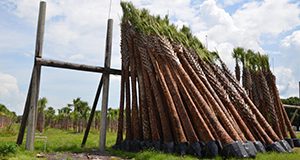 Palms are woody monocots characterized by the production of adventitious roots from the base of the trunk. Unlike the woody roots of dicots, such as oaks, gumbo limbo, and sea grapes, palm roots have no secondary thickening. Also, unlike trees, palms are incapable of repairing damage to their trunks. Most importantly, the life of a palm is dependent upon the continued good health of the single growing bud known as the meristem. Thus, if the palm bud is killed, the entire palm or the palm cane will eventually die. This 4-page fact sheet discusses harvesting and transplanting sabal palms, cropped transplants, and regenerated transplants. Written by Stephen H. Brown and Tim Broschat, and published by the UF/IFAS Environmental Horticulture Department, September 2017.
Palms are woody monocots characterized by the production of adventitious roots from the base of the trunk. Unlike the woody roots of dicots, such as oaks, gumbo limbo, and sea grapes, palm roots have no secondary thickening. Also, unlike trees, palms are incapable of repairing damage to their trunks. Most importantly, the life of a palm is dependent upon the continued good health of the single growing bud known as the meristem. Thus, if the palm bud is killed, the entire palm or the palm cane will eventually die. This 4-page fact sheet discusses harvesting and transplanting sabal palms, cropped transplants, and regenerated transplants. Written by Stephen H. Brown and Tim Broschat, and published by the UF/IFAS Environmental Horticulture Department, September 2017.
http://edis.ifas.ufl.edu/ep543
ENH1157/EP417 Railroad Vine: Ipomoea pes-caprae, a Florida Native Plant
ENH1157,a 7-page illustrated fact sheet by Stephen H. Brown and Joy Hazell, describes this pantropic vine found on beaches and dunes throughout peninsular Florida — geographic distribution, ecological function, growth habit, morphology and reproduction, and planting and maintenance guidelines. Includes references. Published by the UF Department of Environmental Horticulture, February 2010.
http://edis.ifas.ufl.edu/ep417
PP256/PP172 Rusts on Ornamentals in Florida
PP-256, a 6-page illustrated fact sheet by Philip F. Harmon, Carrie L. Harmon, Aaron J. Palmateer, Stephen H. Brown, presents information on four representative rust diseases of ornamentals, including gladiolus rust, daylily rust, frangipani rust, and guava rust. Includes references. Published by the UF Department of Plant Pathology, May 2009.
http://edis.ifas.ufl.edu/PP172
